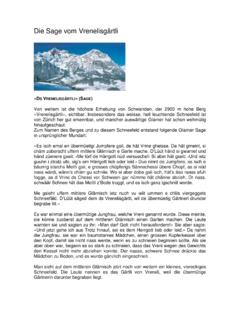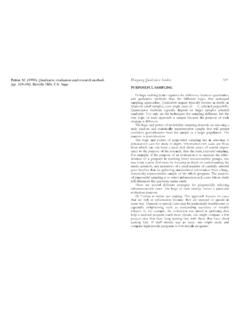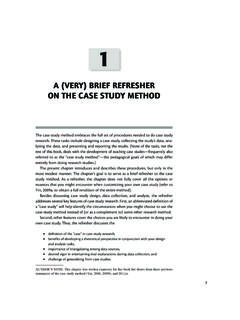Transcription of Executive Summary SAGE October 2017, Pneumococcal ...
1 1 Executive Summary sage October 2017, Pneumococcal Conjugate Vaccine Session Introduction Currently, WHO has recommended the use of either a 10-valent or 13-valent Pneumococcal conjugate vaccine (PCV10 and PCV13, respectively), for all infants worldwide. For routine immunization, WHO has recommended that PCV can be administered using either a 2p+1 or 3p+0 schedule, though 3p+1 schedules are also used in some countries[1]. A total of 141 countries have introduced PCV into their national immunization program, and 7 out of the 10 countries with the highest Pneumococcal disease burden have recently introduced the vaccine[2].
2 Since the introduction of the first PCV (PCV7) in 2000, global reductions in Pneumococcal disease burden in children under 5 years of age have been observed. The number of deaths attributable to Pneumococcal disease has been halved since 2000 among HIV negative children under 5, from approximately 600,000 to 294,000 deaths in 2015. It is estimated that nearly 200,000 deaths have been averted since 2000 specifically because of PCV use[3]. Despite these demonstrated reductions, Pneumococcal disease burden remains high, particularly in lower income regions. Pneumonia, from all causes, accounts for approximately 16% of childhood deaths in low and middle income countries (LMICs), compared to 5% in high income countries; pneumococcus is a leading cause of these pneumonia deaths[4].
3 Furthermore, the substantial costs of PCV (particularly for middle or lower middle income countries not supported by Gavi) have led to gaps in the introduction and coverage of the vaccines due to concerns about the sustainability of PCV immunization programs. As the availability of PCV impact data by schedule and product continues to accrue, the review of such evidence is necessary to facilitate countries in making decisions on which product and schedule to use, as well as whether to conduct catch up immunization programs. The Strategic Advisory Group of Experts ( sage ) on Immunizations PCV Working Group (WG) assessed results from the Pneumococcal Conjugate Vaccine Review of Impact Evidence (PRIME) Systematic Review, modelled evidence on the impact of catch up immunization, and additional ad hoc data to update existing recommendations on 2 three key PCV issues: dosing schedule, product choice, and catch up immunization.
4 The discussions held by the WG were framed around the following three questions: Question 1: Dosing Schedule How does PCV administered to healthy children in a 2p+1 schedule compare with the vaccine administered in a 3p+0 schedule, with respect to immune response in vaccinated children and impact on clinical outcomes (IPD, pneumonia, and mortality), and nasopharyngeal carriage in the vaccinated children as well as unvaccinated age groups through indirect protection? Question 2: Product Choice Is the impact or effectiveness of PCV10 and PCV13 (using either WHO recommended dosing schedules) different, based on data reporting immune response following vaccination, and impact on NP Carriage and clinical outcomes (IPD, pneumonia and mortality) in vaccinated children as well as unvaccinated age groups through indirect protection?
5 Question 3: Catch Up Vaccination What additional value does catch-up vaccination with 1 or 2 doses of PCV in vaccine-na ve healthy children offer as compared with vaccination of only age eligible children (as per the vaccination schedule in the country) in relation to the overall impact on Pneumococcal disease? The following sections of this document will provide an overview of available evidence reviewed by the WG, as well as proposed PCV policy recommendations and suggested research priorities. Available Evidence Reviewed by the PCV sage WG Section briefly summarizes the key sources of primary and secondary data that served as the evidence base for the WG to revise recommendations.
6 3 The PRIME Systematic Review: Objectives, Approach, and General Conclusions PRIME was a systematic review assessing primary evidence from literature assessing impact and effectiveness of each PCV dosing schedule and product. Primary evidence of catch up immunization impact was limited but assessed where available. A full report of the results from this extensive review can be found on the WHO sage website. Context and Purpose of PRIME A 2010 systematic review, referred to as the PCV Dosing Landscape Study, informed the scientific community and sage on PCV schedule(s) with a focus on the differences in immunogenicity and colonization/disease impact between 3- and 4-dose schedules using the 7-valent PCV (PCV7) product[5].
7 The available data were predominantly from high-income countries. The PCV Dosing Landscape Study contributed to the sage review to recommend the use of either a series of 3 primary doses without a booster or 2 primary doses with a booster given at 9 months of age or later. A substantial number of immunogenicity and post-introduction disease and colonization impact assessments have become available since 2010, particularly from low-and-middle-income countries (LMICs) which are known to have Pneumococcal epidemiologic characteristics that differ from those in higher income settings. Since 2010 two expanded serotype products, PCV10 and PCV13, have both been available, and PCV7 was removed from immunization programs in that year.
8 The majority of the recent PCV impact data are from the use of these two WHO prequalified products, and these data have yet to be summarized for decision-making on the optimal use of PCV globally. Both the currently licensed PCV10 and PCV13 products contain antigens from serotypes 1, 4, 5, 6B, 7F, 9V, 14, 18C, 19F and 23F. PCV13 also contains antigens from serotypes 3, 6A and 19A. This update to the previous review provides further evidence to the scientific community and policy makers regarding which PCV schedule(s) and product(s) are optimal, considering both the direct and indirect effects of the vaccines. PRIME Methods and Data Analysis: A systematic literature review of 14 databases was conducted to include relevant data published in English from January 1, 2010-December 31, 2016, with ad-hoc additions through June 2017.
9 All relevant citations (evaluating PCV10 and/or PCV13) included in the PCV Dosing Landscape Study 4 systematic review (1994-2010) were also brought into this analysis and Summary document [1]. In addition, relevant unpublished data were considered. A set of core exclusion criteria were established for all outcomes in order to ensure that effectiveness and impact estimates were comparable across studies and technically relevant to address the proposed research questions on optimal use of PCV globally. A total of 207 studies were analyzed for the final report. Types of Studies: Included: Randomized control trials (RCTs), non-randomized trials, and observational studies reporting pre (baseline) and post vaccine introduction incidence rates for disease outcomes or prevalence for carriage Excluded: Incidence data from only the PCV post-introduction era, and case-series data for disease outcomes (pre-post or post- only) Outcomes: Direct and indirect impact on invasive Pneumococcal disease (IPD), pneumonia syndrome, Pneumococcal nasopharyngeal (NP) carriage, as well as Pneumococcal serotype specific immunogenicity measured by antibody concentrations (IgG).
10 Outcomes reporting serotype specific data (IPD, immunogenicity, and NP carriage) were prioritized for review from the WG. Products: PCV13 & PCV10 Schedules: 3+0 and 2+1 dosing schedules (2+0 and 3+1 schedule studies were included where technically relevant) 5 Descriptive analyses reveal the amount and variability of the data by product, schedule and outcome evaluated. Meta-analyses were done only where appropriate (immunogenicity and NP carriage), and not for all outcomes of interests. A narrative synthesis is based on the information summarized in tables with the characteristics and findings of the included studies: country, year of publication, number of participants, age range, name of vaccine, immunization schedule, comparator, study design, outcomes, magnitude of effect, and confidence interval.














